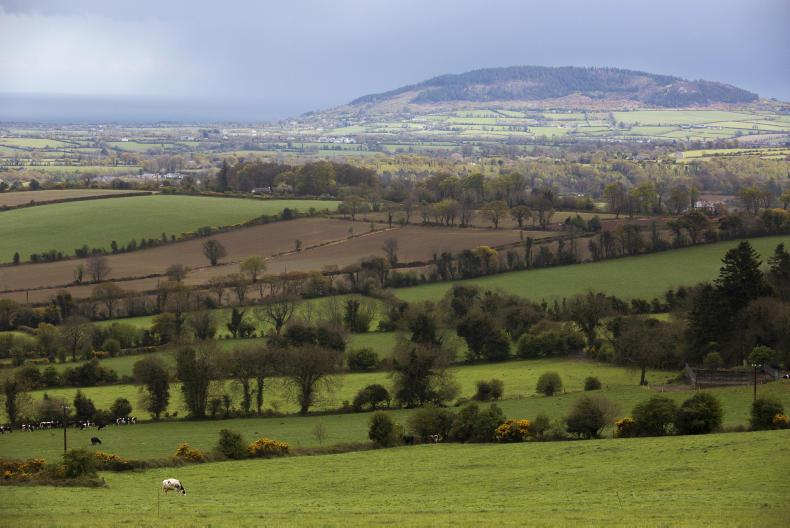Is spring finally here or is mother nature just toying with us once again?
Ground conditions had improved considerably here over the last couple of weeks, but a couple of nights’ heavy rain towards the end of last week has set thing back a bit again. I took my first grass measurement for the year last week, average farm cover is around 420kg dry matter per hectare.
It’s probably lower than I would like it to be, though some of the farm had been grazed with sheep in December, which would have lowered the cover a bit, but it also helps to thicken and refresh the sward, so I think it’s worthwhile. I’ll probably wait a couple of weeks before I measure again but it will be interesting to see what kind of growth rate I’m achieving.
Kicking on the grass
I spread the whole farm two weeks ago, with one bag of 18:6:12 to the acre. This is my first application of the year. I usually would start with half a bag of urea/acre, especially on ground that has received slurry earlier in the season, but I decided this year to go with 18:6:12 on everything from the get go. Mostly just as an experiment to see if the response is any better than urea.
My P and K indices are fairly OK to begin with, but I just feel that a bit of compound helps the grass plant to spring into life.
Bad weather
A batch of heifers that had to be rehoused during the bad weather are back at grass for the past couple of weeks and are starting to clean up nicely, the plan is to sell them in early May when hopefully there will be plenty of grass buyers active. Silage ground that received 2000 gallons of cattle slurry back in February has a reasonable cover of grass on it and is currently being grazed by a batch of cows and calves that were let out at the weekend.
I scanned 80% of the herd last week even though the breeding season is not over yet. I always do this every year because, as I don’t tend to open the doors and let all cows out to grass on the same day, knowing what is in calf allows me to pull cows away from the bulls and put them to grass without any fear of missing an insemination.
I also find that the change in diet from silage to grass tends to mess with the breeding cycle, so the more cows that are settled in calf before they go to grass the better. All cows have received their clostridia vaccination booster, the calves will get their second shot in four to six weeks when they will also receive a mineral bolus.
Read more
Full coverage: James Strain
Is spring finally here or is mother nature just toying with us once again?
Ground conditions had improved considerably here over the last couple of weeks, but a couple of nights’ heavy rain towards the end of last week has set thing back a bit again. I took my first grass measurement for the year last week, average farm cover is around 420kg dry matter per hectare.
It’s probably lower than I would like it to be, though some of the farm had been grazed with sheep in December, which would have lowered the cover a bit, but it also helps to thicken and refresh the sward, so I think it’s worthwhile. I’ll probably wait a couple of weeks before I measure again but it will be interesting to see what kind of growth rate I’m achieving.
Kicking on the grass
I spread the whole farm two weeks ago, with one bag of 18:6:12 to the acre. This is my first application of the year. I usually would start with half a bag of urea/acre, especially on ground that has received slurry earlier in the season, but I decided this year to go with 18:6:12 on everything from the get go. Mostly just as an experiment to see if the response is any better than urea.
My P and K indices are fairly OK to begin with, but I just feel that a bit of compound helps the grass plant to spring into life.
Bad weather
A batch of heifers that had to be rehoused during the bad weather are back at grass for the past couple of weeks and are starting to clean up nicely, the plan is to sell them in early May when hopefully there will be plenty of grass buyers active. Silage ground that received 2000 gallons of cattle slurry back in February has a reasonable cover of grass on it and is currently being grazed by a batch of cows and calves that were let out at the weekend.
I scanned 80% of the herd last week even though the breeding season is not over yet. I always do this every year because, as I don’t tend to open the doors and let all cows out to grass on the same day, knowing what is in calf allows me to pull cows away from the bulls and put them to grass without any fear of missing an insemination.
I also find that the change in diet from silage to grass tends to mess with the breeding cycle, so the more cows that are settled in calf before they go to grass the better. All cows have received their clostridia vaccination booster, the calves will get their second shot in four to six weeks when they will also receive a mineral bolus.
Read more
Full coverage: James Strain






 This is a subscriber-only article
This is a subscriber-only article










SHARING OPTIONS: